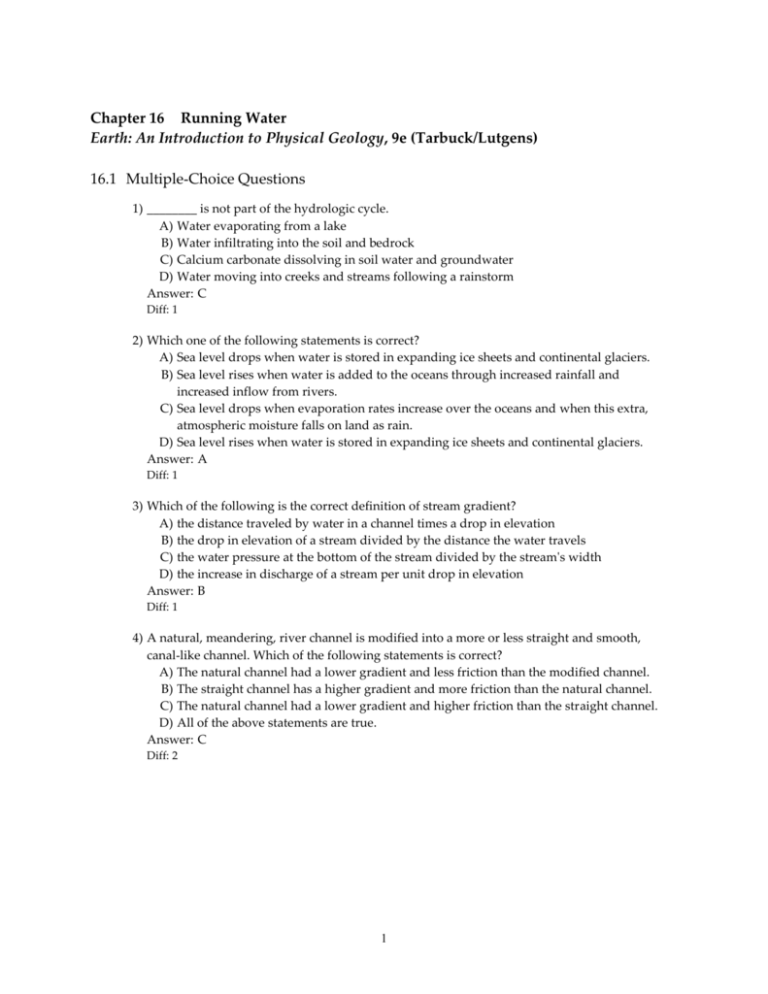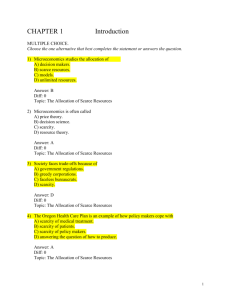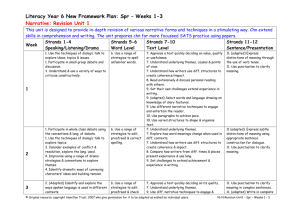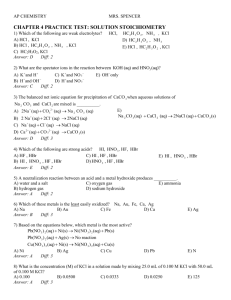Running Water Test Questions: Geology 9e
advertisement

Chapter 16 Running Water Earth: An Introduction to Physical Geology, 9e (Tarbuck/Lutgens) 16.1 Multiple-Choice Questions 1) ________ is not part of the hydrologic cycle. A) Water evaporating from a lake B) Water infiltrating into the soil and bedrock C) Calcium carbonate dissolving in soil water and groundwater D) Water moving into creeks and streams following a rainstorm Answer: C Diff: 1 2) Which one of the following statements is correct? A) Sea level drops when water is stored in expanding ice sheets and continental glaciers. B) Sea level rises when water is added to the oceans through increased rainfall and increased inflow from rivers. C) Sea level drops when evaporation rates increase over the oceans and when this extra, atmospheric moisture falls on land as rain. D) Sea level rises when water is stored in expanding ice sheets and continental glaciers. Answer: A Diff: 1 3) Which of the following is the correct definition of stream gradient? A) the distance traveled by water in a channel times a drop in elevation B) the drop in elevation of a stream divided by the distance the water travels C) the water pressure at the bottom of the stream divided by the stream's width D) the increase in discharge of a stream per unit drop in elevation Answer: B Diff: 1 4) A natural, meandering, river channel is modified into a more or less straight and smooth, canal-like channel. Which of the following statements is correct? A) The natural channel had a lower gradient and less friction than the modified channel. B) The straight channel has a higher gradient and more friction than the natural channel. C) The natural channel had a lower gradient and higher friction than the straight channel. D) All of the above statements are true. Answer: C Diff: 2 1 5) How does urbanization (paving, etc.) affect runoff and infiltration in a small, previously forested, drainage basin? A) both decrease B) runoff decreases; infiltration increases C) both increase D) infiltration decreases; runoff increases Answer: D Diff: 1 6) Which of the following must result in a lower base level for rivers and streams? A) sea level drops; land subsides B) sea level falls; land rises C) sea level rises; land subsides D) sea level rises; land rises Answer: B Diff: 2 7) ________ make up the suspended loads of most rivers and streams. A) Dissolved ions and sand B) Dissolved salts C) Silt and clay-sized, detrital grains D) Sand and gravel that move during floods Answer: C Diff: 1 8) ________ describes the total sediment load transported by a stream. A) Capacity B) Discharge C) Competence D) Hydro-load factor Answer: A Diff: 1 9) At the head of a delta, the major channel splits into smaller channels that follow different paths to the sea. These smaller channels are known as ________. A) endotributaries B) exotributaries C) distributaries D) cotributaries Answer: C Diff: 1 2 10) Why is a bird-foot delta like that of the present-day Mississippi below New Orleans likely to change naturally toward one with the shape of an equilateral triangle like the upper-case, Greek letter delta (D)? A) Present-day distributaries have higher gradients than potential new ones. B) Potential, new, major distributary channels have steeper gradients than existing channels. C) Potential, new, distributary channels have higher gradients, causing downcutting of the existing channels. D) Increased sediment loads since the mid-19th century have caused the major distributaries to be filled with sand. Answer: B Diff: 2 11) In the absence of cutoff, how does a river meander loop behave over time? A) The gradient is raised as the loop lengthens, and the channel migrates toward the cut or inner bank of the loop. B) The gradient is raised as the loop shortens, and the channel migrates away from the cut or outer bank of the loop. C) The gradient is lowered as the channel lengthens and migrates toward the cut or outer bank of the loop. D) The gradient is lowered as the loop shortens, and the channel migrates toward the cut or inner bank of the loop. Answer: C Diff: 2 12) A ________ stream pattern is developed only on growing mountains like volcanoes or where the land surface is tectonically doming upward. A) radial B) dendritic C) boreal D) trellis Answer: A Diff: 1 13) A ________ stream pattern develops on lands underlain by tilted or folded, alternating hard and soft, sedimentary strata. A) dendritic B) radial C) trellis D) boreal Answer: C Diff: 1 3 14) ________ is an abandoned, cutoff, meander loop. A) A builtrail B) An oxbow C) A cowhock D) A gatorback Answer: B Diff: 1 15) ________ are characteristics of downcutting streams and a youthful stage of valley evolution. A) Rapids and lots of whitewater B) Wide floodplains C) A U-shaped, cross-valley profiles D) Meandering channels and natural levees Answer: A Diff: 1 16) Many larger rivers in the Colorado Plateau region meander in deep, narrow canyons and have no floodplains. How could this happen? A) Original, youthful streams continued to downcut as the land rose. B) Original, old age streams downcut as the land gradually rose. C) As sea level dropped, the original youthful streams matured into old-age streams. D) As sea level rose, the original, old age streams were rejuvenated. Answer: B Diff: 1 17) A water gap is ________. A) a low sag between adjoining segments of a natural levee B) the narrow strip of land separating two meander loops C) a vertical-walled canyon resulting from very rapid stream downcutting D) a short segment of canyon formed where a river flows across the outcrop area of a resistant, ridge-forming rock layer Answer: D Diff: 1 18) Which of the following is the only correct response concerning the location and causes of the extraordinarily severe, 1993, flooding on the Mississippi River and tributaries? A) lower basin; heavy rains in late spring and early summer B) upper basin; rapid melting of an unusually deep snow pack in early spring C) lower basin; very heavy, late summer rains associated with a severe hurricane D) upper basin; very heavy, sustained rainfall in the late spring and early summer Answer: D Diff: 1 4 19) Which one of the following statements correctly describes how stream terraces can form? A) Base level drops; the stream aggrades its channel, and the former floodplain is left below the present elevation of the stream. B) A temporary base level is eliminated; the stream downcuts upstream from the old temporary base level, and the former floodplain is left well above the present elevation of the stream. C) Base level rises; the stream downcuts, and the old floodplain is left well above the elevation of the present-day channel. D) A temporary base level is eliminated; the stream aggrades its channel upstream from the old temporary base level, and the former floodplain is left well above the present elevation of the stream. Answer: B Diff: 2 20) ________ are components of the hydrologic cycle that release water vapor directly to the atmosphere. A) Runoff and infiltration B) Evaporation and transpiration C) Precipitation and runoff D) Discharge and transportation Answer: B Diff: 1 21) What is the drop in water surface elevation divided by the distance the water flows? A) stream discharge B) hydraulic capacity C) hydrologic resistance D) stream gradient Answer: D Diff: 1 22) The ________ river has the largest discharge of any in the world. A) Nile B) Mississippi C) Congo D) Amazon Answer: D Diff: 1 23) Which one of the following does not apply to stream turbulence and average velocity? A) channel shape; bed roughness B) laminar flow; dissolved load C) discharge; stream gradient D) stream gradient; channel roughness Answer: B Diff: 1 5 24) Which one of the following is true concerning a major river system? A) Upstream tributaries generally have lower gradients than the major river. B) Channel bed roughness and turbulence generally increase downstream. C) Upstream tributaries generally have higher competencies than the major river. D) Discharge decreases below junctions with perennial tributaries. Answer: C Diff: 1 25) ________ generally constitutes the highest percentage of the annual sediment load moved by a stream. A) Bed load B) Dissolved load C) Suspended load D) Saltation load Answer: C Diff: 1 26) Where is erosion concentrated along a meandering stream? A) on the straight channel segments that connect the meander loops B) on the outer parts of the meander loops or bends C) at the unconsolidated point bars D) on the inner banks of the meander loops Answer: B Diff: 1 27) Which one of the following would cause stream rejuvenation? A) sea level rises B) a shift from downcutting to lateral cutting C) the land is uplifted D) when unstable distributaries in a delta are abandoned Answer: C Diff: 1 28) Which one of the following statements is true concerning natural levees? A) Depositional features formed at times of low discharge. B) Mostly fine sand and silt that build up during floods. C) Erosional features left behind when meander cutoff occurs. D) Form the high, steep banks of a downcutting stream. Answer: B Diff: 1 29) In a ________ drainage pattern that is generally developed in areas underlain by tilted or folded strata, tributary streams flow along outcrop areas of the softer strata. A) trellis B) dendritic C) coparallel D) radial Answer: A Diff: 1 6 30) A ________ drainage pattern is common in the Appalachian Valley and Ridge Province. A) dendritic B) polygonal C) circular D) trellis Answer: D Diff: 1 31) A stream begins at an elevation of 200 meters and flows a distance of 400 kilometers to the ocean? What is the average gradient? A) 2 m/km B) 2 km/m C) 0.5 m/km D) 0.5 km/in Answer: C Diff: 1 32) ________ in a delta are essentially cross strata inclined toward deeper water. A) Backset beds B) Topset beds C) Foreset beds D) Bottomset beds Answer: C Diff: 1 33) The ________ describes the movement of water through Earth's hydrosphere. A) aqualytic cycle B) aquatic cycle C) precipitation cycle D) hydrologic cycle Answer: D Diff: 1 34) ________ describes the particle transport mode in streams intermediate between suspension and rolling along the bottom? A) Siltation B) Alluviation C) Impact leaping D) Saltation Answer: D Diff: 1 35) Which of the following features characterize wide streams and valleys? A) natural levees; broad floodplains B) rapids; channel bed potholes C) waterfalls; entrenched meanders D) V-shaped valley cross-sections Answer: A Diff: 1 7 36) Entrenched meanders are evidence for what sequence of geologic events? A) Land uplift was followed by stream downcutting. B) Lateral cutting by streams was followed by subsidence of the land. C) A sea level rise was followed by stream downcutting. D) Stream downcutting was followed by a rise in base level. Answer: A Diff: 1 37) Which one of the following best describes how urbanization affects small-stream watersheds? A) Infiltration is reduced; lag time between storms and peak runoff is increased. B) Infiltration increases slightly; lag time between storms and peak runoff decreases. C) Infiltration decreases; lag time between storms and peak runoff is shortened. D) Infiltration and lag time between storms and peak runoff increase. Answer: C Diff: 2 38) A dam and reservoir are constructed on a graded river. What will happen? A) Deposition upstream from the dam; channel downcutting below. B) Channel downcutting upstream from the dam; deposition below. C) Deposition upstream and downstream from the dam. D) Channel downcutting upstream and downstream from the dam. Answer: A Diff: 1 16.2 Word Analysis Questions Examine the words and/or phrases for each question below and determine the relationship among the majority of words/phrases. Choose the option which does not fit the pattern. 1) A) natural levees B) rapids C) backswamps D) yazoo tributaries Answer: rapids Diff: 1 2) A) gradient Answer: capacity B) velocity C) capacity D) discharge B) pothole C) cut bank D) natural levee B) point bar C) natural levee D) delta B) dams C) floodplains D) channelization Diff: 2 3) A) abrasion Answer: natural levee Diff: 1 4) A) cut bank Answer: cut bank Diff: 1 5) A) artificial levees Answer: floodplains Diff: 1 8 16.3 True/False Questions 1) Alluvial fans develop at unusual locations where stream gradients abruptly increase for a short distance. Answer: FALSE Diff: 1 2) Gradients usually decrease downstream in a major river system. Answer: TRUE Diff: 1 3) Alluvium refers to stream deposits, mainly sand and gravel. Answer: TRUE Diff: 1 4) The lowest base level for most streams is sea level. Answer: TRUE Diff: 1 5) Natural levees are constructed of machine-compacted sand and mud; artificial levees are made of concrete. Answer: FALSE Diff: 1 6) Point bars are depositional features located along the outer portions of meander bends. Answer: FALSE Diff: 1 7) Rapids and waterfalls are characteristic of laterally cutting streams. Answer: FALSE Diff: 1 8) After a meander is cut off, the gradient through the newly formed cutoff is steeper than the gradient along the abandoned meander loop. Answer: TRUE Diff: 1 9) The lower Mississippi River has the largest discharge of any river in North America. Answer: TRUE Diff: 1 10) Stream discharge is defined as the quantity of water flowing past a specific channel location per unit time. Answer: TRUE Diff: 1 11) Urbanization lowers peak discharges on small streams by routing the runoff directly to the stream. Answer: FALSE Diff: 1 9 12) A stream flowing out from a lake cannot downcut below the water surface elevation of the lake. Answer: FALSE Diff: 1 13) Evapotranspiration and average velocity are both important components of the hydrologic cycle. Answer: FALSE Diff: 1 14) Most precipitation in land areas originates by transpiration and by evaporation from lakes and rivers. Answer: FALSE Diff: 1 15) A V-shaped valley and no floodplain indicate a youthful, downcutting stream. Answer: TRUE Diff: 1 16) Lateral cutting and deposition are important factors in floodplain development. Answer: TRUE Diff: 1 17) With the passage of time, deposition and erosion gradually shorten the channel length of a meander loop. Answer: FALSE Diff: 1 18) Foreset beds are part of a deltaic, depositional sequence. Answer: TRUE Diff: 1 19) For the same discharge, gradient, and channel cross-section, a stream with a boulder-strewn bed would be more turbulent than one with a sandy bed. Answer: TRUE Diff: 1 20) The lowermost distal portion of the modern Mississippi Delta is a typical bird-foot delta. Answer: TRUE Diff: 1 16.4 Short Answer Questions 1) The lowest elevation limiting stream erosion is called ________. Answer: base level Diff: 1 2) ________ is the boundary line separating adjacent, stream drainage basins. Answer: A stream divide Diff: 1 10 3) ________ is the release of water vapor to the atmosphere by plants. Answer: Evapotranspiration Diff: 1 4) ________ is defined as the drop in elevation of the stream surface divided by the distance the water flows. Answer: Gradient Diff: 1 5) ________ is the total quantity of sediment carried by a river. Answer: Capacity Diff: 1 6) ________ is the sediment transport mode in which sand grains alternately bounce up into the water column, sink, and roll or skip along the bottom before bouncing again. Answer: Saltation Diff: 1 7) ________ is the quantity of water flowing past a certain stream cross section per unit time. Answer: Discharge Diff: 1 8) What stream characteristic is measured by the size of the largest particle that a stream can move? Answer: competence Diff: 1 9) ________ refers to sediments deposited from streams. Answer: Alluvium Diff: 1 10) Which component of the hydrologic cycle describes the recharge of water to the soil and groundwater systems? Answer: infiltration Diff: 1 16.5 Critical Thinking Questions Use complete sentences, correct spelling, and the information presented in Chapter 16 to answer the questions below 1) A city located on a large river has a history of moderate flooding over its 150-year history. However, the severity and magnitude of flooding has increased dramatically in the past 30 years. Give some possible reasons, both natural and human-induced, as to why such increased flooding might occur. Diff: 3 2) Briefly compare those stream characteristics that decrease in a downstream direction with those that increase downstream. Also, indicate whether these changing stream characteristics tend to favor erosion or deposition of sediments. Diff: 3 11 3) What generalizations can you make regarding the geology of a given area by examining stream drainage patterns on a topographic map? Give some examples. Also, are there limitations to such generalizations? Diff: 3 16.6 Visualization Questions 1) Where would the words "head", "mouth", "steep gradient", and "gentle gradient" be located on the diagram below? Answer: See figure 16.8 in chapter 16 of Earth, 9e Diff: 1 2) Label the cut bank and the point bar on the diagram below. Answer: See figure 16.13 in chapter 16 of Earth, 9e Diff: 1 12 3) Label the oxbow lake on the diagram below. Answer: a) See figure 16.14 in chapter 16 of Earth, 9e Diff: 1 13 4) On the spaces provided below each illustration, name the type of drainage pattern that is illustrated. a) ________ b) ________ c) ________ 14 d) ________ 15








